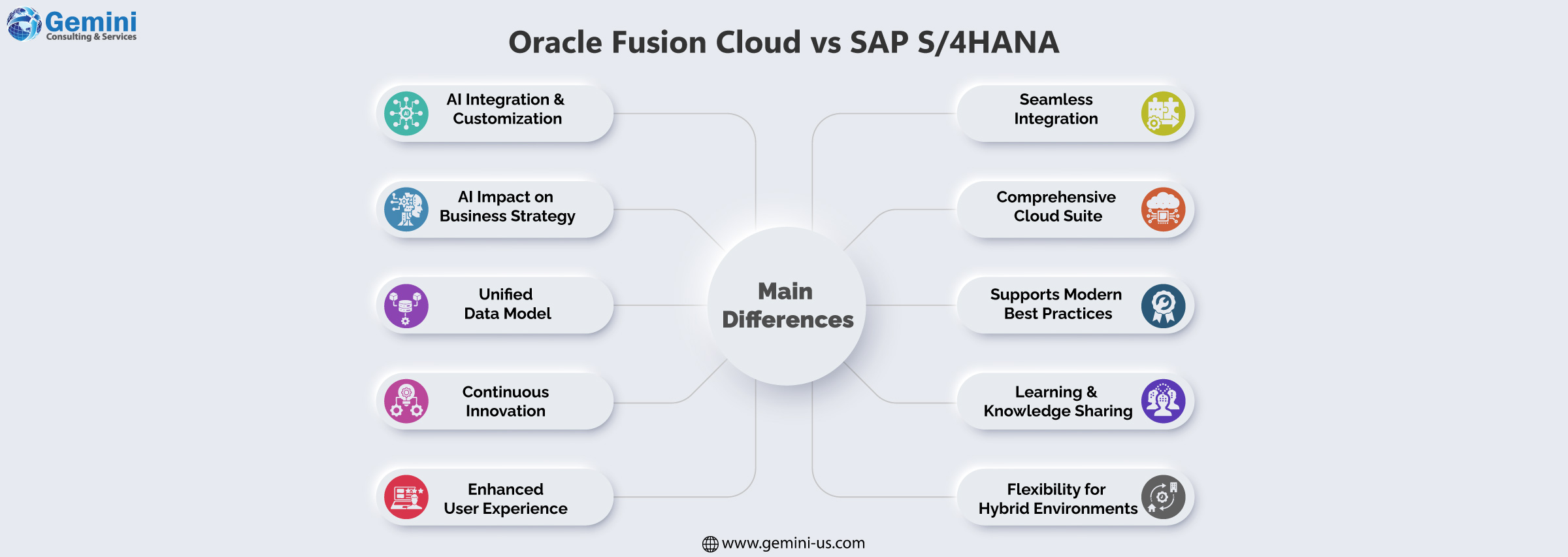Oracle and SAP are two of the leading platforms in the world of enterprise resource planning (ERP) and cloud applications. While both offer advanced solutions for businesses, Oracle Fusion Cloud Applications stand apart from SAP S/4HANA in several crucial ways. Oracle’s AI-driven, integrated, and highly flexible platform is designed to provide companies with seamless innovation and better decision-making capabilities. Below, we explore the ten main differences between Oracle Fusion Cloud Applications and SAP S/4HANA Cloud.

1. AI Integration and Customization
Oracle Fusion Cloud Applications are built with Artificial Intelligence (AI) embedded directly into the software, helping businesses make faster and more informed decisions. Oracle’s AI is designed to stay within its secure environment, ensuring that customer data remains private and is not shared with third-party providers. In contrast, SAP S/4HANA shares customer data with external hyperscalers like Microsoft Azure and Google Cloud. Moreover, Oracle does not charge extra for AI features, unlike SAP, which adds additional costs for AI capabilities in its existing applications.
2. AI Impact on Business Strategy
The transformative power of AI is driving businesses to become more dynamic. With Oracle’s AI-driven solutions, businesses can create highly personalized customer experiences, predict demand, adjust pricing dynamically, and automate operations. By contrast, SAP’s fragmented approach to AI makes it harder to integrate AI consistently across its entire suite of applications. This difference is key for companies aiming to stay agile in a rapidly evolving business landscape.
3. Unified Data Model
Oracle’s unified data model ensures consistency across its applications. Master data such as customer, employee, product, and supplier definitions are standardized, ensuring that they are accurate and consistent throughout the entire system. This eliminates the discrepancies that often arise when managing multiple datasets. SAP, on the other hand, operates with separate data models across different applications, which can lead to integration and reporting challenges.
4. Continuous Innovation with Quarterly Updates
Oracle Fusion Cloud Applications benefit from continuous quarterly updates that improve performance and add new features like AI, machine learning (ML), and digital assistants. These updates are synchronized with updates to the underlying Oracle Cloud Infrastructure (OCI), ensuring seamless integration. In contrast, SAP customers using Microsoft Azure or Google Cloud for infrastructure may face challenges in aligning updates between different technology stacks.
5. Enhanced User Experience and Accessibility
Oracle Fusion Cloud Applications are designed with inclusivity in mind, offering a user-friendly interface that accommodates a wide variety of workstyles and physical abilities. Features like personalized guidance through Oracle Journeys help users navigate complex tasks, while AI assists in providing personalized, context-aware recommendations. SAP’s user experience is often less intuitive, with less emphasis on accessibility for diverse user needs.
6. Seamless Integration Across Business Processes
Oracle’s approach to integration ensures a true end-to-end system, where all business processes, from supply chain management to manufacturing and order fulfillment, are interconnected. This allows companies to quickly adapt to changes and improve long-term planning. In contrast, SAP’s fragmented ecosystem often leads to integration issues, especially for customers who rely on disparate systems from SAP’s various acquisitions (e.g., Concur, Ariba, SuccessFactors).
7. Comprehensive Cloud Suite
Oracle provides a complete suite of integrated cloud applications, including ERP, CRM, HCM, and SCM, which can be customized and extended as needed. This flexibility is key for businesses looking to scale and adapt quickly. On the other hand, while SAP offers cloud applications, its focus on certain functions like HR or financials means businesses may need to rely on multiple vendors to meet their needs.
8. Supporting Modern Best Practices
Oracle integrates next-generation technologies like AI, IoT, and mobile capabilities into its cloud applications to automate processes and help businesses operate more efficiently. Unlike SAP’s older, ERP-centric models, Oracle’s Modern Best Practices help companies stay ahead in today’s fast-changing market. With Oracle, businesses can quickly adapt to mergers, acquisitions, and shifts in business strategies without being held back by rigid legacy systems.
9. Learning and Knowledge Sharing
Oracle leverages its own experiences by running its finance operations on Oracle Fusion Cloud ERP, providing valuable insights to its customers. The Oracle Cloud Customer Connect community, with over 200,000 members, facilitates collaboration and knowledge-sharing between users and Oracle product development teams. This community-driven approach helps Oracle improve its applications based on real-world customer feedback. SAP lacks a similar community platform and often faces challenges in aligning its product roadmap with customer needs.
10. Flexibility for Hybrid Environments
Oracle’s cloud applications are designed to seamlessly integrate with existing on-premises systems. This makes it easier for businesses to transition to the cloud at their own pace, without requiring a full replacement of their current infrastructure. Oracle’s composable architecture also allows companies to scale and customize their cloud applications as needed. SAP, on the other hand, may face challenges when attempting to integrate its cloud solutions with legacy systems due to its more monolithic approach.

If your enterprise is looking at leveraging the capabilities of Oracle Fusion Cloud Applications, we are here to help you. Gemini Consulting & Services have experienced consultants who can customize Oracle’s cloud applications to improve your productivity. Contact us to learn more about Gemini’s services and capabilities.
Conclusion: Why Choose Oracle Fusion Cloud Over SAP S/4HANA?
When evaluating Oracle Fusion Cloud Applications versus SAP S/4HANA, it’s clear that Oracle’s integrated, AI-powered platform offers several advantages in terms of user experience, innovation, and seamless integration. Whether you’re looking for flexibility, a unified data model, or a complete suite of applications, Oracle provides a comprehensive and secure solution designed for the modern business landscape.



